When The Royals Came to Town
It was 1901. Australia had achieved Federation and Melbourne staged an elaborate celebration to mark the opening of the First Parliament of the Commonwealth of Australia. Celebrations started on Monday 6th May, when the Duke and Duchess of Cornwall and York arrived at St. Kilda Pier, punctually at 2 o’clock, and closed on the day of their departure from Port Melbourne by the Royal Yacht, Ophir, on Thursday 16th May. [1]
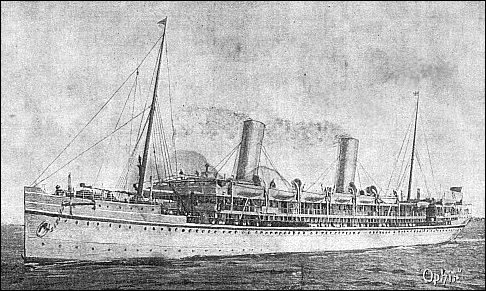
The Royal Yacht, Ophir. Courtesy: Len and Dorothy Allnutt.
A Celebrations Committee of the Cabinet and Staff headed by The Honorable A.J. Peacock, MLA, Premier of Victoria; The Honorable W. McCulloch M.L.C., Minister of Public Works as chairman and Mr. Joseph Gibbs as manager of functions and entertainment, worked together with fourteen subcommittees to organize the memorable events which would mark this decisive step in Australia’s History. [2] During the festivities, their Royal Highnesses the Duke and the Duchess of York and Cornwall were in the public eye, along designated routes on their way to and from Government House to perform official duties and attend functions, almost every day. The main event was of course the Opening of the Parliament, held on Thursday, 9th May and the Official Programme cites that on this day:
His Excellency the Governor – General will leave Government House at 11 o’clock, and their Royal Highnesses will follow him a few minutes later to attend the opening of Parliament. The procession will proceed over the appointed route to the Exhibition Buildings. The ceremony will occupy about an hour, after which Their Royal Highnesses will return to Government House, by his Excellency’s carriage.
In the evening Their Royal Highnesses will leave Government House at five minutes to nine, and proceed, via Prince’s bridge, Flinders Street, to witness the State Concert given in their honour by the Commonwealth Government. They are due to arrive there at 9.15 and will remain there about 10.30, and returning by the same route to Government House. [3]

A Page from the Program for the Opening of Parliament, 1901. Courtesy of Len and Dorothy Allnutt.
To offer the Royals respite from their duties and the crowds, there was a day of rest on Sunday, 12th May, and to add a little variety, on Monday 13th May, Their Royal Highnesses visited the gold mining town of Ballarat by train, departing from Spencer Street at 10.30 am, returning at 6.30 pm the same evening. There was just one other occasion for ‘Their’ personal pleasure, and that was a visit to an unspecified venue in the country for a day of shooting. [4]
Where were the locals during this time of celebration?
Along with other Victorians, by purchasing the official Programme of Celebrations for sixpence, they were able to follow the movements of their Royal Highnesses or choose to attend other nationalistic, sometimes dazzling, events. Frequent trains, trams and buses took them to destinations all over the city to enjoy events such as the March of the Australian Stockmen; the Chinese Procession during the day, or the March of the Fire Brigades by torchlight in the evening. Then again, spectators could just wander around enjoying the illumination of the City with bands playing in the streets or catch a tram to the beach to watch the naval illumination of Hobson’s Bay, off Port Melbourne. [5]
On Wednesday, 8th May, there was a spectacular Illumination, Fireworks and Aquatic Display at Albert Park, where during the afternoon, the people could cheer for the winner of the First Class Open Handicap Yacht Race among other boating competitions, and later, win prize monies in the fun Tub, Wading, Sea Horse and Umbrella races or Walking the Greasy Pole Event. [6] In the evening, during the Illumination and Fireworks Display from 7.30 pm, there were some 37 different pyrotechnic devices to gasp at, from the first Volley of Signal Maroons, to the Glimpse of Fairyland at the end. [7] Each device had an evocatively exotic name, inviting spectators to anticipate its unfolding beauty. The Jupiter’s Thunderbolt, the Cloud of Rubies and Emeralds, Explosion of Jewel Mines, the Niagara of Fire, and a Volley of Silver Saucissons, hissing and darting through the air like fiery serpents were among a host of others planned to thrill. In addition to this, they had 200 Hand Lights for firing on the boats, as well as a Grand Illumination of the Island by large Prismatic Lights! [8]
One could hardly imagine that the Pyrotechnics at Albert Park Lake could be outdone, but at the Domain on the evening of Friday, 10th May, and perhaps to remind the populace of the respect the new Commonwealth still owed to The Crown, the spectacular Fireworks display of 88 pyrotechnic devices (designed by someone called Pain), included ‘Colossal portraits of the Duke and Duchess of York, surrounded by laurel leaves and emblems of the Empire, and flanked by the motto, “Welcome to Australia." [9] This had been preceded by a Special motto device, in which ‘the loyal sons of the Empire welcome their royal guests’ were worked out in large black letters of great brilliance’. [10] Each device must have been more spectacular than the last. There was even an ascent of a monster magnesium balloon planned weather permitting, ‘with electric showers, trails of incandescent lights 200 feet long floating in the air, and the most powerful magnesium lights ever exhibited, lighting up the entire vicinity.’ And the finale, described as a ‘Grand flight of large coloured rockets with double effect, comprising a huge flight of rockets with stars of dazzling whiteness, which will be immediately followed by a second flight of coloured stars, the whole finally blending into a magnificent aerial bouquet of 1,000 rockets’ must have been almost beyond belief. [11] Talk about BIG! What a fitting celebration of the new Aussie nation!
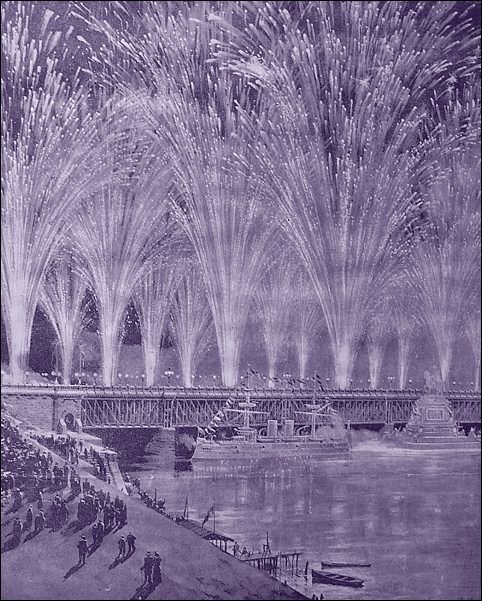
Spectacular Fireworks at the Domain, May 10th 1901. With the illuminated Yacht near the arch of the Bridge. Courtesy of Len and Dorothy Allnutt.
What effect in reality did the Federation of Australian States into a Commonwealth have on the local population?
Until Federation in 1901, Australians were simply known as Colonials. Along with the rest of the nation, the residents of Kingston were glad of the demise of this parochial term of their nationality. “As I understand it," Len Allnutt says, “ there was no such thing as an Australian in those days. They were just Colonials, and they were more or less sort of looked down upon. Those who had been born in Britain seemed to think they were a cut above those born here," he adds. “My grandfather was referred to as a Colonial, when he was a young man. But when Federation came, the word Colonial disappeared, which was a good thing," he declares. [12]
Len, whose wife Dorothy had the remarkable foresight to retain the Programme of Celebrations centred around the Opening of the First Parliament in Melbourne on May 10, 1901, recalls two memorable occasions involving Kingston with these festivities.
The first of these Len cites as the splendid dinner to which his mother’s uncle was invited, nay, summonsed to attend. There had been a Prizes to Public Schools at the Exhibition buildings on Tuesday, 14th May, when “The Grand Old Flag" was hoisted all over the State and Public Schools throughout the Commonwealth, simultaneously with the ceremony at 12 noon on that day. A dinner followed this at Government House at 8pm. [13] This was no ordinary invitation, he recalls. “Roughly, from memory, it would be about 6" x 12". It was so big that you could have framed it, and it had the bust of the Duke of York on the top, and the crossed flags, Australian and the British flags, and it was in gold lettering," he says. [14] “You weren’t invited!" he stresses. “You were requested to attend this dinner which the Duke of York was going to attend! And many years later, when my mother was throwing out some rubbish, we came across it. It had faded by then, and she said… I can see her now, - ‘nobody will want that’, - aimed it out, and it was burnt!" [15]
The other occasion of particular note to Kingston, says Len, was the March of the Australian Stockmen before the Duke and the Duchess of York and Cornwall. [16] This was scheduled during the second day of the festivities, when three representatives from Cheltenham rode down Melbourne’s Swanston Street in the Stockman’s Parade. [17] One of these was Roderick Mills, market gardener in Heatherton, better known by his stage name, Saltbush Bill. Among many other honors, Saltbush had the distinction of being part of a roughrider troop selected by famous Australian rough rider Phillip McConville, to perform at the Coronation Festivities for George V. [18]
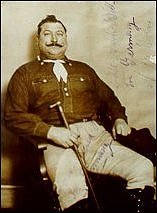
Roderick Mills alias Saltbush Bill. Courtesy of his granddaughter, Sylvia Roberts.
Len takes us behind the scene of the March of the Stockmen, held on Tuesday, 7th May for the Opening of Parliament Festivities, with another true story about Saltbush Bill, written here, as he told it. “As part of the celebrations of Federation, there was a Stockman’s Parade held in Melbourne. It was advertised right throughout the state, and anybody could go in it, as long as you had a horse. They wanted good musterers," says Len. “The idea was that they would get them from all over the State, from all districts. But what you had to do, you had to register and you had to send in your name and five pounds, which in those days was quite a considerable amount of money. You were required to come to Melbourne the day before, and the 5 pounds covered the stabling and feed of your horses, and your accommodation and meals. It also covered a uniform. If you rode in the Parade, you had to wear a uniform," he says. “The uniform consisted of a hat, a shirt, and moleskin pants. The deal was that you came in the day before, collected the uniform, and then rode in the Parade the next morning, and then the Parade would be dispersed," he explains. [19]
“Now Saltbush Bill thought that he would like to ride in the Parade and represent Cheltenham, so he came to my uncle who was a neighbour and a close friend, and said he wanted to ride in the Stockmen’s Parade, and asked if my uncle would ride with him. What he wanted was a man to ride on each side of him… a rider on each side, whose horses would not take fright when he used the stock whip," says Len [20] “So my uncle said that he would ride with him," he goes on, “and they had to get another one to ride on the other side. I don’t know who that was, but that was the three of them. Saltbush Bill said to my uncle, ‘Well, you write in, send in the money, but say that I must have an extra large uniform. The ordinary uniform won’t fit me. I want an extra big one.’ My uncle said yes, so he wrote the letter, and sent the money. The day before the Stockman’s Parade, they went to Melbourne to collect the uniforms, and when Saltbush Bill was given his, he said ‘that uniform is no good to me, it won’t fit me. My friend here wrote in and said he wanted a big one.’ The bloke giving out the uniforms (he must have been a bit of a Bureaucrat) said ‘there’s only one size uniform’. That’s all there is. Take it. If you don’t take the uniform, you don’t ride in the Parade. Go now if you don’t want it!’
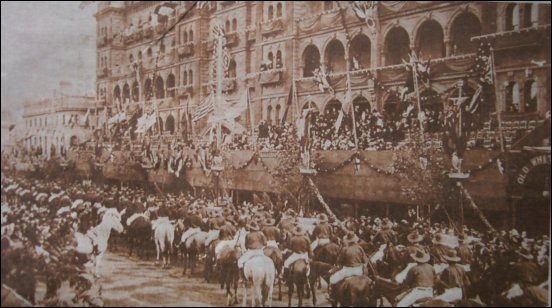
Stockmen riding through streets of Melbourne.
So with bad grace, Saltbush took the uniform. He was in a bad humour then. The next morning, when he got up, he had a bit of trouble getting into the uniform, the pants were very tight and he was a bit frightened to mount the horse, so my uncle and the other bloke gave him a hand (to mount) so the pants wouldn’t bust. And the Parade started. As they came down Swanston Street, Saltbush started to crack the whips, and as he cracked the whips, the crowd began to cheer, and his mood lifted, and he was quite happy. And that’s how three representatives of Cheltenham rode in the Stockman’s Parade for Federation," he says, [21], linking the locals to the festivities with this true story.
Apart from the instance of Royalty coming to town for the Opening of Parliament celebrations, says Len, there was one other occasion of which the area could be justifiably proud. Even though the Duke of York ventured into the country on his visit in 1901, the venue was undisclosed, and it was not until 1920, when the then Prince of Wales chose to play polo at Creswick’s Allandale stud farm in Mentone, that Royalty really came to Kingston, says Len, and tells this story. [22]
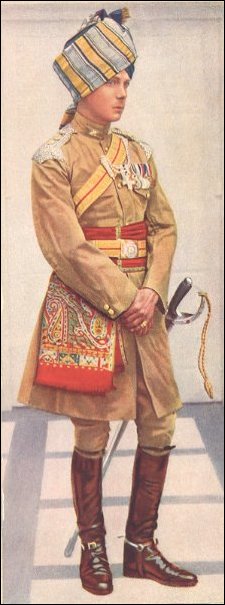
Edward, Prince of Wales, in uniform of Colonel-in-Chief of the Prince of Wales's Own Scinde Horse.
“ We come up to 1920 now, with the visit of the Prince of Wales. I don’t know if it is widely known, that he visited Mentone. If you go down Lower Dandenong Road, before you get to the airport, on the north side you will see Allandale Road. That was named after the Allandale Stud Farm,’ says Len. “It was a large stud farm owned by a man named Creswick. Creswick bred racehorses, and he was a very wealthy man. He owned extensive properties in NSW and Queensland and Allandale was where he bred racehorses. At the back of the property, which backed onto my grandfather’s property, it was completely secluded. Creswick got my grandfather to build him his own private training track where he trained the racehorses. Nobody could see them, in the centre, at the training track. He had a polo course as well as playing racehorses. He and all his family were real horse people. They used to follow the hounds; they would compete in jump events and all that sort of thing, all over the country. And they were polo players too. In those days, polo was very different, only the very wealthy could afford to play polo," says Len [23]
“When the Prince of Wales visited Melbourne in 1920, as well as his official engagements, he carried out a number of private engagements and parties, and that sort of thing, and Creswick had a private engagement with him," Len recalls. “It was a game of polo down on Allandale, and the story goes that when he got there and all the polo gentlemen were there to meet him, they had agreed before the match that they would all do the right thing; that they would be handicapped, to give him a start … ‘Bah! Nonsense,’ said the Prince, and he wouldn’t have any of that at all, he said. He was just the same as anybody else, and he’d take his chance along with them. And that’s how they played the polo. Of course everybody flocked to Royalty in those days, Len maintains. It was far more popular than it is today. It was the be-all and end-all of everything then, he says. So after the event, he understands that when rumour spread that the Prince of Wales had come to Mentone, people were all going past Allandale’s saying ‘Oh! That’s where the Prince played polo!’ and even amongst the kids, they’d say ‘that’s where the Prince of Wales was… in there, that’s where he came to Mentone, and he played the polo match, right down here in Mentone’, he recalls. [24]
“Just to continue with Allandale," says Len, “after Creswick’s death it was sold to a racehorse trainer named Tyne, and went through many hands then. It remained a stud farm until eventually it was sold for housing, but despite the fact that there’s housing all over it now, the fact remains that it was the Allandale Stud Farm and that the Prince of Wales was the famous visitor. The Prince of Wales was later Edward VIII and then he was the Duke of Windsor, but that records his visit to Mentone," says Len, to round off a great narrative depicting how local history was made, when the Royals came to town.
Footnotes

